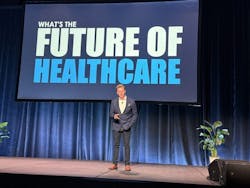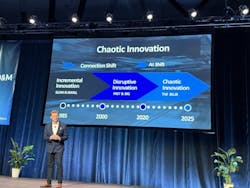In his keynote on the morning opening of the MD&M West conference and exposition, medical device technologist, author and healthcare futurist Nick Webb shared insights gathered from five years of in-depth exploration into the future of healthcare. He pressed upon the audience not only to think about the overarching future of healthcare but to consider their own futures within this dynamic and ever-evolving sector. “What is the future for you?” he asked.
Webb articulated an understanding of the duality present in the healthcare trajectory—one filled with opportunities for organizations willing to adapt and fraught with challenges for those that resist change.
Understanding the Future of Healthcare
Webb initiated his keynote by posing a critical question: “Is the future of healthcare good or bad?” The answer: “Yes.” He reframed this inquiry, directing attention to personal implications for those working within healthcare, particularly within the medical device industry. His optimistic outlook underscored that organizations prepared to embrace transformative changes could find themselves positioned for extraordinary growth.
READ MORE: Elevating Expertise with MD&M West’s Educational Opportunities
He centered on several trends that are reshaping healthcare:
- Anticipatory genomics. The ability to foresee potential health outcomes and personalize treatment plans.
- Decentralization. Shifting away from traditional healthcare models toward more patient-centered, accessible care.
- Artificial intelligence. AI’s potential to streamline processes, amplify patient engagement and improve outcomes by providing actionable insights from vast data sets.
Pillars for Success in a Chaotic Environment
“How do we grow during this chaotic change?” he asked. To successfully navigate the complexities of modern healthcare, Webb highlighted three essential pillars:
- Consumerism. Recognizing the shift toward a consumer-centric healthcare landscape, Webb said that organizations must move beyond traditional transactional models. It is no longer sufficient to provide medical devices based solely on technical specifications; companies must now offer holistic, experiential value that resonates with diverse stakeholders across the healthcare ecosystem. He cited real-world examples, illustrating how organizations that prioritize exceptional user experiences can significantly outperform competitors.
- Emerging technologies. Webb encouraged attendees to harness emerging technologies beyond AI, including advanced analytics, robotic process automation and connected medical devices. He encouraged taking a proactive approach to technology adoption, reminding the audience that failure to integrate these innovations can lead to obsolescence. He also talked about the opportunity for organizations to reduce operational costs and improve efficiency by effectively leveraging these technological advancements.
- Staffing and Human Experience Innovation (HXI). Webb said a key component for success lies in cultivating a workplace culture that prioritizes employee well-being and innovation. He introduced the concept of HXI, asserting that organizations that nurture a positive work environment not only enhance employee satisfaction but also drive creativity and productivity. He noted that fostering a culture of happiness among staff is crucial for achieving outstanding organizational performance.
Engaging Real-World Examples
Throughout his presentation, Webb used relatable anecdotes and examples from various sectors to underscore the importance of understanding evolving consumer expectations and illustrate how patient experiences are being reshaped through technology and innovation.
He also drew attention to the rise of wearables and implantables as tools for empowering patients, focusing on how these devices facilitate better health management, preventative care and informed decision-making. He projected that the integration of these technologies would significantly change patient-provider interactions, emphasizing the need for organizations to adapt to these new paradigms.
READ MORE: As Seen at MD&M West 2025: Product Showcases, Solutions and More
A Vision for the Future
While wrapping up his keynote, Webb delivered a call to action for industry professionals, urging leaders in the medical device sector to adopt a mindset centered on empathy, innovation and resilience. By prioritizing the delivery of both economic and experiential value, organizations can craft strategies that resonate with an increasingly discerning consumer base, he said.
Webb also noted the importance of layered and dynamic value—advocating for a reframed perspective in which healthcare organizations view themselves as integral parts of a broader human experience ecosystem. He said that success in this new landscape hinges on collaborative approaches, innovative thinking and a dedicated focus on enriching human experiences throughout the healthcare continuum.
Webb left the audience with a clear understanding that the future of healthcare is not only bright for those willing to change, but also critical for the well-being of individuals and communities alike. By embracing the ongoing transformations, healthcare professionals have the opportunity to play a pivotal role in advancing care and improving patient outcomes, ultimately ensuring a thriving and sustainable healthcare environment. “Lean into the blur of chaotic change,” he urged.
Editor’s note: For more show coverage, be sure to check out our MD&M West 2025 content hub.
About the Author
Sharon Spielman
Technical Editor, Machine Design
As Machine Design’s technical editor, Sharon Spielman produces content for the brand’s focus audience—design and multidisciplinary engineers. Her beat includes 3D printing/CAD; mechanical and motion systems, with an emphasis on pneumatics and linear motion; automation; robotics; and CNC machining.
Spielman has more than three decades of experience as a writer and editor for a range of B2B brands, including those that cover machine design; electrical design and manufacturing; interconnection technology; food and beverage manufacturing; process heating and cooling; finishing; and package converting.
Email: [email protected]
LinkedIn: @sharonspielman
Facebook: Machine Design
YouTube: @MachineDesign-EBM


